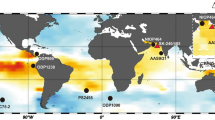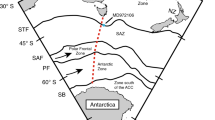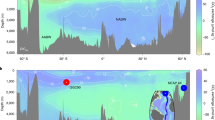Abstract
It is generally accepted view that the ventilation of Southern Ocean during the last deglaciation was the key factor in atmospheric CO2 rise. Further, other sites were identified, like the western equatorial Pacific, the Sub-Antarctic Atlantic and the eastern equatorial Pacific. Now there are evidences that CO2 was also released from the eastern Arabian Sea. The Arabian Sea is unique in characteristic, being land locked from the North and affected by monsoon winds and seasonal reversing circulations. Furthermore, the CO2 outgassing noticed during deglaciation makes it an interesting region to understand if the outgassing occurred from the deeper waters and hence led to any rise in deepwater \([\rm{CO}_3^{2-}]\).
Similar content being viewed by others
References
Allen, K.A., Sikes, E.L., Hönisch, B., Elmore, A.C., Gilderson, T. C., Rosenthal, Y. and Anderson R.F. (2015) Southwest Pacific deep water carbonate chemistry linked to high southern latitude climate and atmospheric CO2 during the Last Glacial Termination. Quat. Sci. Rev., v.122, pp.180–191. doi: https://doi.org/10.1016/j.quascirev.2015.05.007
Anderson, R.F., Ali, S., Bradtmiller, L.I., Nielsen, S.H.H., Fleisher, M.Q., Anderson, B.E. and Burckle, L.H. (2009) Wind driven upwelling in the Southern Ocean and the deglacial rise in atmospheric CO2. Science, v. 323, pp.1443–1446. doi: https://doi.org/10.1126/science.1167441.
Archer D., Winguth, A., Lea, D. and Mahowald, N. (2000) What caused the glacial/interglacial atmospheric pCO2 cycles? Rev. Geophys., v.38(2), pp.159–189.
Broecker, W.S. and Peng, T.H. (1982) Tracers in the Sea. Eldigio Press, 690p.
Broecker, W.S. and Sutherland, S. (2000) Distribution of carbonate ion in the deep ocean: support for a post-Little Ice Age change in Southern Ocean ventilation? Geochem. Geophys. Geosys., v.1, pp. 1525–2027. doi:https://doi.org/10.1029/2000GC000039.
Bryan, S.P., Marchitto, T.M. and Lehman, S.J. (2010) The release of 14C-depleted carbon from the deep ocean during the last deglaciation: evidence from the Arabian Sea. Earth Planet. Sci. Lett., v.298, pp.244–254. doi:https://doi.org/10.1016/j.epsl.2010.08.025.
Govil, P. and Naidu, P.D. (2010) Evaporation-precipitation changes in the eastern Arabian Sea for the last 68 ka: Implications on monsoon variability. Paleoceanogr., v.25, PA1210. doi:https://doi.org/10.1029/2008PA001687.
Henehan, M.J., et al. (2013) Calibration of the boron isotope proxy in the planktonic foraminifera Globigerinoides ruber for use in palaeo-CO2 reconstruction. Earth Planet. Sci. Lett., v.364, pp.111–122. doi: https://doi.org/10.1016/j.epsl.2012.12.029.
Key, R.M., et al. (2004) A global ocean carbon climatology: Results from Global Data Analysis Project (GLODAP). Glob. Biogeochem. Cycl., v.18(4), GB4031. doi:https://doi.org/10.1029/2004GB002247.
Köhler, P., Fischer, H., Munhoven, G. And Zeebe, R.E. (2005) Quantitative interpretation of atmospheric carbon records over the last glacial termination. Glob. Biogeochem. Cycles, v.19(4). GB4020. doi:https://doi.org/10.1029/2004GB002345.
Lüthi, D., Floch, M.L., Bereiter, B., Blunier, T., Barnola, J.M., Siegenthaler, U., Raynaud, D., Jouzel, J., Fischer, H., Kawamure, K., and Stocker, T.F. (2008) High-resolution carbon dioxide concentration record 650,000–800,000 years before present. Nature, v.453, pp.379–382. doi:https://doi.org/10.1038/nature06949.
Martínez-Botí, M.A., Marino, G., Foster, G.L., Ziveri, P., Henehan, M. J., Rae, J.W.B., Mortyn, P.G. and Vance, D. (2015) Boron isotope evidence for oceanic carbon dioxide leakage during the last deglaciation. Nature, v.518, pp.219–222. doi:https://doi.org/10.1038/nature14155.
Naik, S.S., Naidu, P.D., Foster, G.L. and Martínez-Botí, M.A. (2015) Tracing the strength of the southwest monsoon using boron isotopes in the eastern Arabian Sea. Geophy. Res. Lett., v. 42, pp.1450–1458. doi:https://doi.org/10.1002/2015GL063089.
Palmer, M.R. and Pearson, P.N. (2003) A 23,000-year record of surface water pH and pCO2 in the western equatorial Pacific ocean. Science, v.300, pp.480–482. doi: https://doi.org/10.1126/science.1080796.
Petit, J.R., Jouzel, J., Raynaud, D., et al. (1999) Climate and atmospheric history of the past 420,000 years from the Vostok ice core, Antarctica. Nature, v.399, pp.429–436.
R Core Team (2013) R: A language and environment for statistical computing. R Foundation for Statistical Computing, Vienna, Austria. URL https://doi.org/www.R-project.org/.
Rae, J.W.B., Foster, G.L, Schmidt, D.N. and Elliott, T. (2011) Boron isotopes and B/Ca in benthic foraminifera: proxies for the deep ocean carbonate system. Earth Planet. Sci. Lett., v.302(3–4), pp.403–413. doi:https://doi.org/10.1016/j.epsl.2010.12.034.
Rae, J.W.B., Sarnthein, M., Foster, G.L, Ridgwell, A., Grootes, P.M. and Elliott, T. (2014) Deep water formation in the North Pacific and deglacial CO2 rise. Paleoceanogr., v.29(6), pp.645–667. doi: https://doi.org/10.1002/2013PA002570.
Sigman, D.M. and Boyle, E.A. (2000), Glacial/interglacial variations in atmospheric carbon dioxide. Nature, v.407, pp.859–869.
Sigman, D.M., Hain, M.P. and Haug, G.H. (2010) The polar ocean and glacial cycles in atmospheric CO2 concentration. Nature, v.466, pp.47–55. doi: https://doi.org/10.1038/nature09149.
Skinner, L.C., Fallon, S., Waelbroeck, C., Michel, E., and Barker, S. (2010) Ventilation of the deep Southern Ocean and deglacial CO2 rise. Science, v.328, 5982, pp.1147–1151. doi: https://doi.org/10.1126/science.1183627.
Umling, N.E. and Thunell, R.C. (2017) Synchronous deglacial thermocline and deep-water ventilation in the eastern equatorial Pacific. Nat. Comm., v.8, 14203. doi: https://doi.org/10.1038/ncomms14203.
Watson, A.J., Vallis, G. K., Nikurashin, M. (2015) Southern ocean buoyancy forcing of ocean ventilation and glacial atmospheric CO2. Nat. Geo., v.8, pp.861–864. doi: https://doi.org/10.1038/ngeo2538.
Yu, J., Anderson, R.F. and Rohling, E.J. (2014) Deep ocean carbonate chemistry and glacial-interglacial atmospheric CO2 changes. Oceanogr., v.27(1), pp.16–25. doi: https://doi.org/10.5670/oceanog.2014.04.
Yu, J., Anderson, R.F., Jin, Z., Rae, J.W.B., Opdyke, B.M. and Eggins, S.M. (2013) Responses of the deep ocean carbonate system to carbon reorganization during the last glacial-interglacial cycle. Quat. Sci. Rev., v.76, pp.39–56. doi: https://doi.org/10.1016/j.quascirev.2013.06.020.
Yu, J., Broecker, W.S., Elderfield, H., Jin, Z., Mcmanus, J. and Zhang, F. (2010a) Loss of carbon from the deep sea since the Last Glacial Maximum. Science, v.330, pp.1084–1087. doi:https://doi.org/10.1126/science.1193221.
Yu, J., Foster, G. L., Elderfield, H., Broecker, W. S. and Clark, E. (2010b) An evaluation of benthic foraminiferal B/Ca and δ11B for deep ocean carbonate ion and pH reconstructions. Earth Planet. Sci. Lett., v.293, pp. 114–120. doi:https://doi.org/10.1016/j.epsl.2010.02.029.
Zeebe, R.E., and Wolf-Gladrow, D.A. (2001) CO2 in Seawater: Equilibrium, Kinetics, Isotopes. Elsevier, Amsterdam, 360p.
Author information
Authors and Affiliations
Corresponding author
Rights and permissions
About this article
Cite this article
Naik, S.N., Naik, S.S. Evidences of CO2 Leakage During the Last Deglaciation: The Need to Understand Deep-ocean Carbonate Chemistry of the Arabian Sea. J Geol Soc India 92, 404–406 (2018). https://doi.org/10.1007/s12594-018-1034-3
Received:
Accepted:
Published:
Issue Date:
DOI: https://doi.org/10.1007/s12594-018-1034-3




